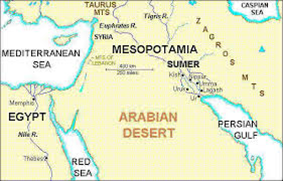Mesopotamia
Conditions d’achèvement
 In this book, you will find summarized information about Mesopotamia and the civilizations that lived there.
In this book, you will find summarized information about Mesopotamia and the civilizations that lived there.
1. The Geographical Setting of Mesopotamia
By roughly 6000 to 8000 years ago, agriculture was well underway in several regions including Ancient Egypt, around the Nile River; the Indus Valley civilization; Mesopotamia, between the Tigris and Euphrates rivers; and Ancient China, along the Yellow and Yangtze rivers. This is because the regular river floods made for fertile soil around the banks and the rivers could also supply fresh water to irrigate crops. It’s no coincidence that as agriculture allowed for denser and denser populations along with more specialized societies, some of the world’s first civilizations developed in these areas as well.

Mesopotamia—mainly modern-day Iraq and Kuwait—in particular, is often referred to as the cradle of civilization because some of the most influential early city-states and empires first emerged there—although it’s not the only place! Its modern name comes from the Greek for middle—mesos—and river—potamos—and literally means a “country between two rivers.” Those two rivers are the Tigris and Euphrates. Not only was Mesopotamia one of the first places to develop agriculture, but it was also at the crossroads of the Egyptian and the Indus Valley civilizations. This made it a melting pot of languages and cultures that stimulated a lasting impact on writing, technology, language, trade, religion, and law.

